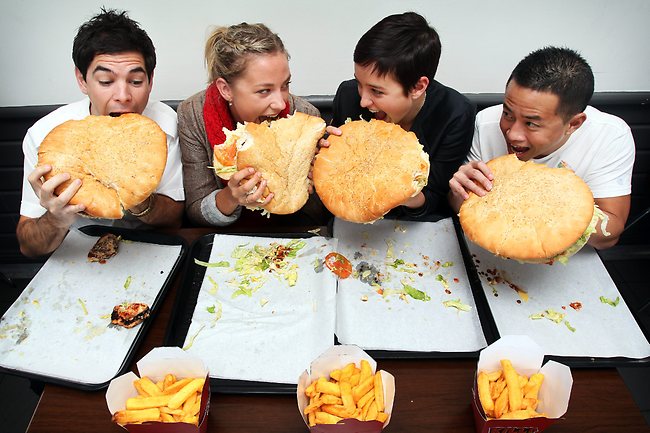by Fabio Parasecoli
from Huffington Post
Supersized food portions are not news, especially if you live in the U.S. But when I first moved here as the correspondent for the Italian food and wine magazine Gambero Rosso, I was constantly amazed by the difference in food servings with what I was used to in Italy. I am less so now, as I’ve spent more and more time in the States, but also because Italians have done their part to increase average food consumption, and not always towards healthier choices. The Mediterranean Diet is more of a nostalgic ideal than a reality, as diet-related conditions have become rampant among adults as well as children.
That said, as both a consumer and a food scholar, I am very interested in how how people eat, what people eat, and what they think about it; what sorts of conversations develop around food. With that in mind, you can imagine I was very intrigued when I saw that the History Channel 2 had dedicated an episode of Modern Marvels to supersized food. The show, if you are not familiar, tries to look at contemporary objects, customs, and systems from the point of view of scientific progress. As the title of the series suggests, the show often embraces a triumphant tone when it comes to technological advances and successes, celebrating the achievements of researchers, inventors, and tinkerers, both as individuals and as members of teams.
Modern Marvels adopts a different approach from, say, Man v. Food on the Travel Channel, where host Adam Richman travels around the country to participate in food challenges. Eating competitions get mentioned in the Modern Marvels episode — and actually we see a Chicago fireman trying to devour a gigantic meat-centered menu in Texas in less than an hour, in front of his adoring family — but the show focuses more so on what happens backstage to achieve the preparation of a 250-pound burger in a 44-pound bun (and its celebratory consumption by a whole team of young football players — not really a surprise), seven-pound hot dogs, 54-inch giant pizzas, 4.5 pound steaks, 5-pound gummy bears and so on. Viewers are invited to reflect on what it takes to cook a huge hamburger, what technical challenges present themselves when you need to bake a pizza large enough to feed 30 “hungry pizza lovers,” and what sort of ingenuity its makers display.
In the interest of the supposed educational and informative aspects of the series, the excesses showcased with glee and pride by the American entrepreneurs are mitigated by an attempt to reflect on why gargantuan portions and eating contests are so present in American popular culture. The voiceover commentator mentions “supersized appetites, resources, and egos” as essential traits of American culture, where supersized homes, electronics, and vehicles are wildly successful, and where food has become cheaper, more available, and more convenient. The burger maker explains that commercial food needs to be entertaining, and that clients love over-the-top items, while the hot-dog maker suggests a Darwinian strive to show power and strength. The show discreetly seems to share these opinions, as the Mongolian hordes of Genghis Khan are indicated as the first consumers of meat patties. Cornell University’s marketing professor Brian Wansink, who has written extensively about eating behaviors, points to the competitive pressure in American culture. To do so, he reports an experiment where young college students are invited to eat as many chicken wings as they can, with and without the presence of cheering spectators. Of course, those performing in front of an audience tended to eat 30 percent more, on average.
Overall, however, the show is less interested in the motivations for exaggerated eating than in its technical aspects. In a way, the fact that Americans tend to consume oversized portions is taken as a given that needs only marginal soul-searching. What’s interesting is how brave entrepreneurs are able to read their customers’ desires and adapt their production to satisfy them. The patrons’ life choices are not their responsibility. Their goal is to increase their clientele and to grow a solid business. Nothing wrong with that, of course, except for the echoes of the political discourse that use the argument of personal responsibility as an excuse to avoid public intervention in health and nutrition issues. What is troublesome is that the cultural and social assumptions behind this approach are accepted as unavoidable facts, rather than as consequence of specific policies and collective choices.


Comments are closed.